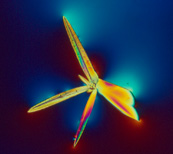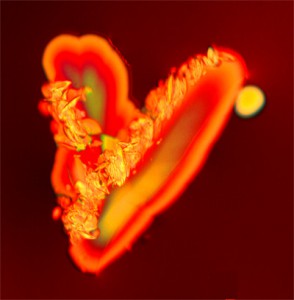Does wine have a soul?
Isn’t it transformed grape juice? Does it pick up soul along with spirit?
When I look at art or listen to a piece of music, some of it touches my soul.
When I first began photographing cells, molecules, then wine under the scope
My soul was touched by the exquisite beauty.In wine especially. And while exploring beauty, symbols began appearing
that I could link to taste, character or essence of a wine, or so I thought.Since symbols are often characterized as masculine (square, linear, bold) and feminine (rounded, swirly, delicate), the designs in wine fit into those shapes as well. So I ask here, is there a feminine wine? A feminine soul to wine?
Nonetheless, whether photoscapes of the inner wine reflect its soul or substance, they certainly offer amazing mysteries to explore… Want to adventure into your wine?
The core soul of all wine is the fecund feminine grape, a fruit of the woody plant vitis vinus. Yet during transformation, the blood of the grape can be coaxed into a more aggressive or subdued nature.
Are there feminine or masculine wines? Does the spirit, or soul of wine, have a gender?
When I interviewed Heidi Barrett for my book, Wine’s Hidden Beauty, at first she said typically she didn’t think of wines as being either masculine or feminine. Then she thought a while and described her Moscato Azul , the only white wine she makes, as a feminine wine.
“Why feminine,” I asked her. “Because it was perfumey and delicate,” she replied. Then she said, “Most red wines are masculine.”
I always see the Moscato as “wine angels”- the above image and on the cover of my book.
Can the soul in wine be the light it carries, the spirit, the perfume it emits, and the joy it permits? The soul of wine shows in the magical devas that populate the nectar, the elements that contribute to the beauty of a fine wine.
Language of the Soul
Noted psychologist and author Marion Woodman reiterates that the soul understands the language of poetry and metaphor, integrating image with feeling, mind, and imagination.
An image becomes a metaphor or symbol when it speaks to the whole person.
Images of the inner wine can act as symbols and speak about the essence of the wine.
Some of the language used to describe wine is based on form – full bodied, prickly, long; or familiar foods – blueberries, peaches; or an aromatic treatise – a tar road, leathery, floral. The words are a product of our experience, they are not the experience. Words are part of the tapestry creating colorful imagery, to evoke a knowing or understanding in the listener. Only if you’ve experienced blueberry can you recognize it in wine.
When I ask myself what I mean by the “soul of wine,” a couple of things come to mind. The photographs of the inner world express part of the soul of wine, the ‘spirits’ of the vine hiding on the microscope slide. The magical forms seem to dance on the glass.
Austrian scientist-philosopher Rudolf Steiner claimed to see the ‘inner life of plants,’ what he called devas or elementals. Derived from Sanskrit “deva” means “to shine.” According to Steiner and the philosophy of theosophy, Devas are the “shining ones.” In Hindu Scriptures, devas refer to life that is invisible. Are the forms seen through the microscope, devas? They certainly are invisible shining reminders of the mysterious invisible qualities that make up life.
 The above writings are adapted from The Soul of Wine chapter in Wine’s Hidden Beauty. BUY NOW!
The above writings are adapted from The Soul of Wine chapter in Wine’s Hidden Beauty. BUY NOW!
What’s wonderful these days, there are more women winemakers who are putting their special touches on wine. In fact, author Deborah Brenner (Women of the Vine) is making a business out of wine made by women. Check out her book and website. http://www.womenofthevine.com/


